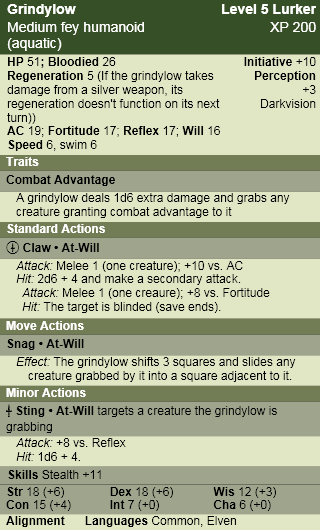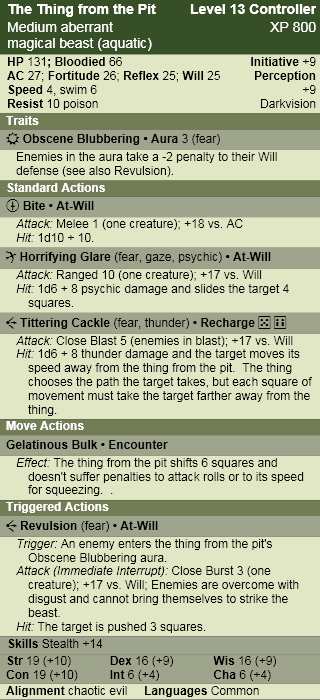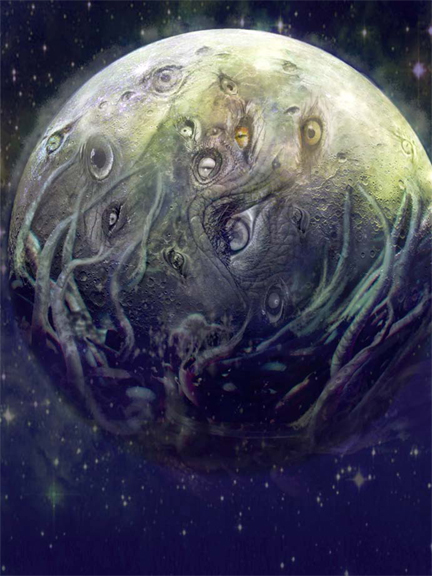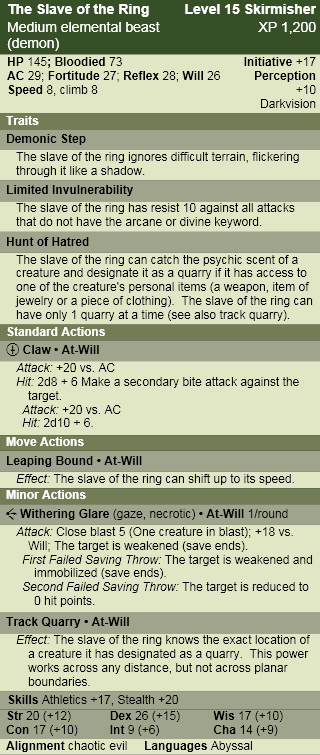Posts Tagged ‘4e’
Black Colossus
February 3, 2011Black Colossus is most well known for containing many of the ideas and plot points that Howard later re-used for his Conan novel The Hour of the Dragon, but is, I think, an excellent story on its own. In particular, I love the introduction. It perfectly captures the feeling and tone of something that would later become integral to D&D: exploring dangerous, ancient ruins and disarming deadly traps.
Spoiler Alert! All of these Hyborian age posts are going to be filled with spoilers. From the summary, to the monster stats they are going to ruin any surprises as to what the monster is, when they pop up in the story and how and why they are killed. You’ve been warned.
Summary
In the three-thousand year old ruins of Kuthchemes, a Zamoran master thief breaks the seal on a strangely preserved ivory dome and releases the wizard Thugra Khotan from his long slumber. Thugra assumes the identity of ‘Natohk the veiled one’ (how very Alucard of him) and raises a horde of desert nomads and elite Kushite warriors. Hungry for conquest and revenge against the Hyborian peoples that overran his kingdom so long ago, Natohk heads north, towards the kingdom of Khoraja.
Before his army reaches its first target, Natohk torments Khoraja’s ruler, the princess Yasmela, with his dark magic. Desperate, Yasmela goes to the temple of Mitra for guidance. Here, the voice of the god tells the princess that her and her people’s only hope is for her to go into the street and place her kingdom in the hands of the first man she meets there.
As fate would have it, she runs into the mercenary Conan whom s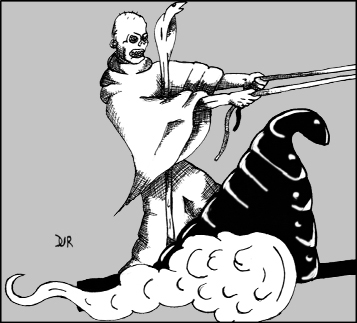 he gives control of the military. The nobles of Khoraja chafe at the idea of being led by a barbarian, but there is little choice, so the army rides out to meet Natohk’s nomads before the city is sieged.
he gives control of the military. The nobles of Khoraja chafe at the idea of being led by a barbarian, but there is little choice, so the army rides out to meet Natohk’s nomads before the city is sieged.
A titanic battle ensues, one where Conan has to face not only Natohk’s sorcery (he uses summoned mists to conceal troop movements and creates magical walls of flame), but also the arrogance and insubordination of Khoraja’s elite.
In the end, Conan’s superior tactics win the battle, but Natohk abducts Yasmela and speeds away on his demon drawn chariot with the Cimmerian in hot pursuit. The sorcerer blames the loss on his lust for the princess and intends to sacrifice her to restore his powers. Fortunately Conan arrives before he is able, hurling his sword and impaling Natohk before he can work any magic (and thus inspiring countless movies and comics where swords have been used as projectiles since).
Thugra Khotan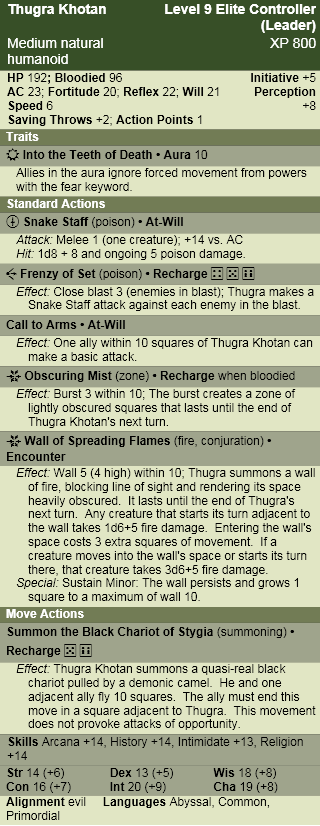
“Natohk faced the Cimmerian – inhumanly tall and lean, clad in shimmering green silk. He tossed back his veil, and Conan looked into the features he had seen depicted on the Zugite coin… Thugra Khotan’s skull-like countenance split in a mummy-like grin.” – Robert E. Howard, Black Colossus.
Lore
Nature DC 15: Thugra Khotan is an ancient Stygian sorcerer who put himself in a deep magical slumber when the city he ruled was overrun by invading barbarians. If he were to awaken, he would surely work to restore his lost glory and take revenge against the nations descended from his enemies.
Thugra Khotan in Combat
Thugra sees himself as a great general and leader of men. He enjoys using his magical abilities to control the battlefield and execute complex strategies and ambushes. His followers obey his orders without question, for they know that Thugra’s displeasure is far worse than anything their enemies can inflict.
The Stygian has no compunctions about withdrawing from a losing battle. After all, armies can be raised, servitors can be summoned, and if need be the sorcerer can seal himself away again and wait for his foes to turn to dust.
Encounters
Thugra Khotan is a master of ritual magic, especially the summoning and binding of demons, and is always accompanied by a barlgura bodyguard. In the years since his city’s downfall, the legend of his power spawned a small but dedicated cult who is now instrumental in recruiting for the sorcerer’s army. The ranks of this horde swell with a motley assortment of bandits, mercenaries, and thugs, lured by the promise of gold, glory and bloodshed.
Most of Thugra Khotan’s targets are well acquainted with the ancient sorcerer long before his minions storm a wall or batter a gate. The Stygian is a master of psychological warfare and takes great pleasure in tormenting his adversaries with sending and other magical forms of intimidation.
Notes
I admit I chose to make Thugra level 9 purely so that he could be teamed up with a barlgura lackey – just like he was in the story (well it wasn’t exactly a barlgura, it was an ape-demon, but I think the barlgura is close enough).
I wasn’t sure if I should make him undead or not since he’s described as looking like a mummy, but I don’t think he was (he was held in stasis in the ivory dome, he had mortal lusts and he was killed by a sword through the chest… I also wanted to differentiate him from a normal D&D lich). If an undead Thugra fits your game better it’s easy enough to change and doesn’t really impact anything.
Finally, the lore check uses the Nature skill simply because that’s the 4e convention for creatures with the natural origin. I think it’s much more appropriate to use the History skill instead (that’s happened before – more and more it looks to me like the knowledge skills and monster origins aren’t lining up as smoothly as I would like in 4e).
Random Encounters: Grindylow
January 18, 2011So at the suggestion of KaosEleQtric regarding my retrospective on Rifts, I’ve converted the grindylow to 4e D&D stats. The exercise reminded me of two things. First, just how much mileage you can get out of a random generator. If you’re stuck for an idea of a challenge to face your players it is definitely worth checking out the multitude of random generators online (if only for a thought experiment to get the juices flowing).
The second thing I was reminded of was just how great 4e handles monster creation. Don’t get me wrong, the system has its flaws, but when it comes to making new monsters its king (and I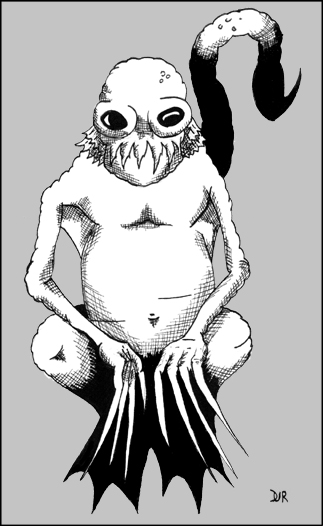 ‘m in love with the monster builder in the adventure tools). I really like the approach the rules foster to monster creation. You tackle the design from the perspective of what you want the monster to do, first and foremost (i.e. shoot eye beams, fly around, or in the case of the grindylow blind people, drag them into the water and sting them), and the end result is a monster that mechanically fulfills that vision. I love that goblins, kobolds, and orcs all feel different in combat because they are mechanically different from one another (now I just wish that the classes in 4e felt a little more different from one another). Could 3e handle any of the monsters I’ve created on this site? Of course it could, I just think it’s a lot easier in 4e (now when it comes to customizing already existing monsters 3e is definitely the king – I love the idea of adding class levels and advancing venerable monster specimens in size).
‘m in love with the monster builder in the adventure tools). I really like the approach the rules foster to monster creation. You tackle the design from the perspective of what you want the monster to do, first and foremost (i.e. shoot eye beams, fly around, or in the case of the grindylow blind people, drag them into the water and sting them), and the end result is a monster that mechanically fulfills that vision. I love that goblins, kobolds, and orcs all feel different in combat because they are mechanically different from one another (now I just wish that the classes in 4e felt a little more different from one another). Could 3e handle any of the monsters I’ve created on this site? Of course it could, I just think it’s a lot easier in 4e (now when it comes to customizing already existing monsters 3e is definitely the king – I love the idea of adding class levels and advancing venerable monster specimens in size).
With all the rumors of 5e floating around (which I think are premature personally), lets hope D&D keeps this approach to monster design.
The Grindylow
“When I was a lad my grandmother used to warn me away from the twisty bog, for that was the home of the grindylow. When I had seen my fifteenth winter I ignored her tales, as young men are wont to do, and set off into the bog with a group of ruffians in search of gold and adventure. Nary a one of them survived, all dragged beneath those black waters by the thing’s long, cruel claws, its tail cracking like a horseman’s whip. The grindylow had found us, and I’ll never forget that crying, screaming little boy I saw reflected in those hateful eyes.”
Lore
Arcana DC 15: Grindylow are malevolent fey that live in noisome bogs and other still bodies of water. They prefer to drown their prey, but are just as capable out of the water.
Arcana DC 20: The touch of pure silver burns the grindylow’s corrupt flesh, preventing it from healing. The creature’s magic aura befouls any water it stays in, earning the grindylow the enmity of Nymphs and Druids.
The Grindylow in combat
Grindylow tend to focus on weaker targets who they can easily blind and drag back to the water. They are slow witted creatures driven by an unceasing hunger for humanoid flesh and are incapable of formulating complex plans on their own.
Encounters
Grindylow are usually too cowardly to tackle a group of well armed heroes on their own, but are often pressed into service by smarter and more powerful creatures like bog and river hags. Grindylow like to hide at the fringes of combat, waiting for an opportunity to grab the wounded and drag them away from their allies.
Notes
If you’re going to use the grindylow in Gamma World add the extradimensional keyword to the monster’s description.
I ended up giving the grindylow regeneration, something the original version didn’t have, since I was emulating the only creatures in D&D with a weakness to silver: lycanthropes (which makes sense since the silver weakness in the Rifts version was emulating the Rifts version of lycanthropes).
The Tower of the Elephant
January 10, 2011Most fans of the Conan stories count The Tower of the Elephant among the best, and I can’t disagree. More important though is the obvious influence this story must have had on D&D. The premise of the adventure is classic D&D stuff: Conan hears a rumor in a bar, forms a party, and braves a monster and trap infested location for treasures which don’t turn out as he expected. And since this story predates the game by a few decades, I guess it would be more correct to say that D&D is classic Conan.
Spoiler Alert! All of these Hyborian age posts are going to be filled with spoilers. From the summary, to the monster stats they are going to ruin any surprises as to what the monster is, when they pop up in the story and how and why they are killed. You’ve been warned.
Summary
From the end of Conan’s career in The Scarlet Citadel, Howard takes us to the beginning, and a much younger and inexperienced Conan. The scene opens on the Maul, a dangerous maze-like section of an unnamed Zamorian city where city guards fear to tread and thieves rule the night. In a dimly lit drinking den Conan hears a Kothian kidnapper gossip of Yara the priest, who dwells in the elephant tower with a great magic gem known as the heart of the elephant. Conan doesn’t understand why a thief with any courage hasn’t simply taken such a treasure yet and the Kothian mocks his naiveté. Conan (even rawer than we’re used to seeing) takes offence and cuts the cur down where he stands. In the chaos following the fight, Conan strides out into the night, the target of his adventure clear.
In the gardens surrounding the tower Conan finds he is not alone in his endeavor. There is another trespasser in the garden by the name of Taurus, the self proclaimed ‘prince of thieves’. The two come to an agreement and proceed together – just in time to dispatch a group of ravenous lions that had been placed in the gardens as savage guards. Conan and Taurus scale the perilous tower and enter, but the lions are not Yara’s only defense. A monstrous spider hiding in the upper chamber poisons Taurus and almost slays the Cimmerian as well. Only Conan’s barbarian instincts see him through the fight alive.
Alone, he continues his quest for the jewel. In one of the tower’s rooms he finds a strange and monstrous creature with emerald skin and the head of an elephant. But instead of a climactic battle with this demon we are given something else. The creature is Yag-kosha, blinded and broken on the r ack – a thing to be pitied. Yag-kosha has been Yara’s prisoner for centuries, working his magic for the priest against his will, unable to escape even by taking his own life.
ack – a thing to be pitied. Yag-kosha has been Yara’s prisoner for centuries, working his magic for the priest against his will, unable to escape even by taking his own life.
The elephantine beast came from green Yag, across the cosmos, while Conan’s people were still primitive ape-men (the same Yag the seeds of Yogtha the Devil Flower were scattered from). Slowly, over vast spans of time his people died out until only Yag-kosha was left, now a shadow of his former self, indentured to the cruel tyrant Yara.
Yag-kosha sees in Conan a means for both liberation from his torture and revenge on the man who inflicted it. He instructs the barbarian to put him out of his misery by cutting out his heart and pouring the blood on the magical jewel he is linked to (the treasure Conan has risked so much to claim). The bloody task complete, Conan is to find Yara and present him with Yag-kosha’s final ‘gift’.
Not one to be squeamish about such tasks Conan obliges Yag-kosha and does as he was instructed. Taking the gem, Conan finds Yara in the haze of the yellow lotus. The dark priest is hostile and outraged at having his meditations disturbed, but goes silent when Conan delivers the heart of the elephant. The strange jewel enspells Yara, shrinking him to diminutive size before absorbing him. Inside the glass walls of the fantastic jewel Conan watches Yara trembling before a fully restored Yag-kosha.
Not sure if what he had experienced was real or not Conan steals away from the tower empty handed as the imposing tower shatters with the first rays of the sun.
Yag Starcaster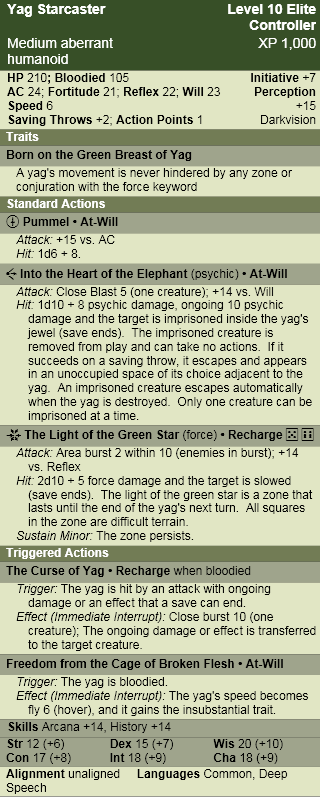
“Conan stared aghast; the image had the body of a man, naked, and green in color; but the head was one of nightmare and madness. Too large for the human body, it had no attributes of humanity. Conan stared at the wide flaring ears, the curling proboscis, one either side of which stood white tusks tipped with round golden balls.” – Robert E. Howard, the Tower of the Elephant
Lore
Dungeoneering DC 15: The Yag are a race of elephant headed, alien beings from the green star of the same name. Each Yag is bonded to a crystal, through which it works powerful magic. The Yag are extremely long lived, so much so that many consider them immortal and worship them as gods.
Dungeoneering DC 20: A Yag can die, but destroying its mortal shell merely frees the creature’s powerful, winged spirit. It is not known what caused the Yag to flee their home, but it must have been an awesome threat both physically and spiritually to send these beings across the void between the worlds.
Yag Starcaster in Combat
Yag are emotionless and methodical in combat. These creatures know that their physical forms are nothing but imperfect reflections of the spirit. For this reason a Yag does not fear death, and in many cases may even welcome it, if it furthers the creature’s goals.
Encounters
Yag are often the leaders of strange star-worshipping cults, perfecting their ancient magic and teaching it to their followers. They care little for the politics of the ‘lesser races’, but the pursuit of their alien goals often brings them and their followers into conflict with outsiders.
It is rumored that powerful star pact Warlocks can ritually bind a Yag into servitude. Such tales usually end with the Yag wreaking bloody vengeance on the Warlock who bound it.
Notes
I really liked the idea of the Yag shrinking PCs down and trapping them in its gem (what we used to call ‘minimus containment’, back in the day), so I cribbed parts of the devourer’s trap spirit ability to make it work. Since the creature is supposed to get more powerful when it dies I thought about making its freedom power work when it got to 0 hit points and adding a healing ability to it, but elite creatures have enough hit points already (especially since it gains insubstantial, it had the potential to make the combat too long). I figured making it ‘die’ when it got bloodied was probably a better call (and makes the creature die and be reborn at a better point in the combat).
I used dungeoneering for the lore check simply because that’s the 4e convention for creatures of the aberrant origin. If you’re not married to that convention then I would recommend using arcana instead, it just seems more appropriate for the astrological/alien bent of this creature than dungeoneering does.
The Scarlet Citadel – Part Two
January 2, 2011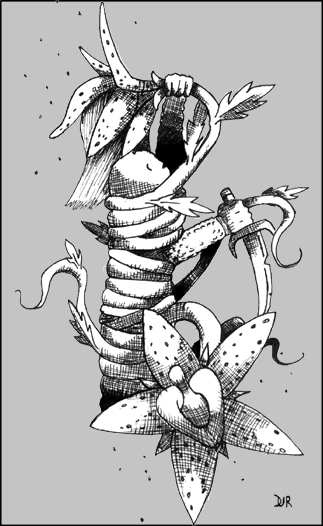 This is the second creature from Robert E. Howard’s The Scarlet Citadel. For the summary of the story as well as the creature from the pit, click here.
This is the second creature from Robert E. Howard’s The Scarlet Citadel. For the summary of the story as well as the creature from the pit, click here.
Spoiler Alert! All of these Hyborian age posts are going to be filled with spoilers. From the summary, to the monster stats they are going to ruin any surprises as to what the monster is, when they pop up in the story and how and why they are killed. You’ve been warned.
Yothga the Devil Flower
In the cold, black depths of the cosmos hangs the star known to warlocks as Yag the accursed. From here, yothga the devil flower spreads its seeds into the world to nourish itself on the thoughts and memories of intelligent creatures. It is said the seeds will only germinate in the lowest, most vile reaches of the underworld, and that as the plant grows, horrible monsters take refuge in its roots. The devil flower feeds by immobilizing its prey in its tendrils and showering them with potent sleeping spores. Once asleep yothga uses its alien flowers to siphon a victim’s thoughts and memories until only an empty soulless shell remains – a slow and ghastly process that can take a decade or longer.
Only those powerful and mad enough to make a pact with the powers of the outer dark know the secrets of cultivating one of yothga’s stalks. For these individuals the devil flower is a powerful tool of unending torture and imprisonment.
Notes
The devil flower is one of the cr eepier creatures of Tsotha-lanti’s dungeon and plays a much more pivotal role in the plot than the thing from the pit, so that alone demanded that I should create statistics for it. But as a stationary plant that didn’t eat enemies so much as imprison them, it seemed much more like a hazard than a monster. The monster summoning comes from Pelias’ comment that pulling the plant up by the roots is dangerous because Conan “…might have found things clinging to the roots against which not even your sword would prevail.” I used the ghoul and wretch of Kyuss simply because they were minions of the right level (I also felt they fit the whole ‘roots in the underworld’ thing), but any level 13 minion would do (a minion balances out the XP of the devil flower being killed with a single action, I think a full fledged creature would be too powerful). Even though the story has yothga putting people to sleep forever (until the plant is removed by an outside force), I thought that in the context of a D&D adventure it was just too deadly, so I added the option of using a healing surge to wake up. If you were running a very gritty and deadly game you could remove that option to reflect the source material more faithfully.
eepier creatures of Tsotha-lanti’s dungeon and plays a much more pivotal role in the plot than the thing from the pit, so that alone demanded that I should create statistics for it. But as a stationary plant that didn’t eat enemies so much as imprison them, it seemed much more like a hazard than a monster. The monster summoning comes from Pelias’ comment that pulling the plant up by the roots is dangerous because Conan “…might have found things clinging to the roots against which not even your sword would prevail.” I used the ghoul and wretch of Kyuss simply because they were minions of the right level (I also felt they fit the whole ‘roots in the underworld’ thing), but any level 13 minion would do (a minion balances out the XP of the devil flower being killed with a single action, I think a full fledged creature would be too powerful). Even though the story has yothga putting people to sleep forever (until the plant is removed by an outside force), I thought that in the context of a D&D adventure it was just too deadly, so I added the option of using a healing surge to wake up. If you were running a very gritty and deadly game you could remove that option to reflect the source material more faithfully.
The Scarlet Citadel – Part One
December 22, 2010The Scarlet Citadel might not be the best Conan story ever written, but I think that page for page, it has more monsters than any other (and they’re some of the coolest as well). That made it pretty hard to narrow it down to a single creature to showcase… so I chose two instead (it’s the holidays). Like the title says, this is part one – I’ll post another fiend later in the week.
Spoiler Alert! All of these Hyborian age posts are going to be filled with spoilers. From the summary, to the monster stats they are going to ruin any surprises as to what the monster is, when they pop up in the story and how and why they are killed. You’ve been warned.
Summary
The second published Conan story takes place after the Phoenix on the Sword. Now that Conan has dealt with his internal enemies, he must now face the external threats to his kingdom. The tale begins with Conan on the field of battle, betrayed by Aquilonia’s neighbor, Ophir, to the King of Koth. Outnumbered his knights are quickly cut down and Conan is captured by the power behind the throne of Koth, the dark wizard Tsotha-lanti. The Kothians spirit Conan back to their capital and imprison him in the dungeons of Tsotha’s infamous scarlet citadel. Here Conan is given an ultimatum: continue to rule Aquilonia as a satrap of Koth or face death at the hands of the horrors below Tsotha’s citadel. As we knew he would, Conan rejects the offer (to put it mildly).
In the dungeons Conan encounters a huge albino serpent, a flopping tentacled thing whose sobs sound too human, an invisible floating creature (that mouths noiseless obscenities at him), and a vampiric plant that feeds on thoughts and memories. From the clutches of the devil plant Conan frees another sorcerer, Pelias, Tsotha-lanti’s chief rival (who might be just as bad as Conan’s captor).
With Pelias’ aid Conan flies back to Aquilonia astride a great bat winged monstrosity just in time to retake his capital and rally the troops. At the head of his army Conan rides southward to meet the armies of Ophir and Koth head on. In the ensuing slaughter the kings of both enemy nations are cut down and Pelias exacts grisly vengeance on Tsotha-lanti.
“Its unstable outlines somewhat suggested an octopus, but its malformed tentacles were too short for its size, and its substance was a quaking jelly-like stuff which made him physically sick to look at. From among this loathsome gelid mass reared up a frog-like head, and he was frozen with nauseated horror to realize that the sound of weeping was coming from those obscene blubbery lips. ” – Robert E. Howard, the Scarlet Citadel
Lore
Dungeoneering DC 20: The thing from the pit is the result of the wizard Tsotha-lanti’s twisted experiments with the Far Realm. Its form is so loathsome that few can overcome their disgust long enough to get within striking distance, and its cackling laugh can unnerve even the most stalwart of warriors.
The Thing from the Pit in Combat
The thing from the pit revels in the fear and disgust it inspires; taking great delight in driving its enemies into deadly traps and other hazards.
Encounters
There are few creatures that can stomach the company of the thing from the pit save mindless oozes and other, equally deformed, aberrations. The latter find the thing from the pit’s ability to shepherd prey across the battlefield invaluable.
Notes
This creature doesn’t play that large a role in the story but it really grabbed my attention. Its appearance was so bizarre it was hard to ignore, and more importantly, it freaked Conan out so much that he flees rather than try to fight it. It made Conan run away. This is the same guy who earlier in the story was able to hold perfectly still while a giant snake reared over him dripping acidic burning venom onto his legs. I wanted the thing from the pit’s powers to reflect that. The creature isn’t much of a threat on its own, but you combine it with other creatures, hazards and traps and I think it becomes quite deadly (in the story it almost gets Conan to fall down a well in his flight from it).
Even though this story takes place after the phoenix on the sword, I decided to make it a lower level than the slave of the ring – Tsotha-lanti’s creation just doesn’t end up hurting Conan like Thoth-Amon’s summoned demon did.
In terms of the picture I found it quite a challenge to draw, and going by Howard’s description it went through a few iterations. In the end I opted for a less true octopoid body and instead drew inspiration from Jim Holloway’s illustration of the yochlol from the 1e Monster Manual II.
Random Encounters: Paean for the Outer Dark
December 18, 2010I was up late staring out the window, thinking about star pact Warlocks (I love the implied setting of these characters), the dark void between the worlds, and Deities and Demigods (with tentacles) when a certain song by Rush came on…
Which led me to uncover this lost scrap of arcane knowledge, acid etched into paper thin sheets of adamantine:
Excerpt from Paean for the Outer Dark
Invisible to telescopic eye
Dark Hadar
The star that would not dieAll who dare
To seek her source
Are swallowed by
A deadly forceThrough the void
To be destroyed
Or is there something more?Atomized — at the core
Or through the astral door —
To soar…I set a coarse just east of Caiphon
And northwest of Acamar
Flew into the light of Delban
Sailed beyond the cold white starsOn my ship the ‘Sea of Fate’
Wheeling through the great beyond
Headed for the heart of Ihbar
With the black blade that it once spawnedBlackrazor, her siren song
My ship cannot resist her long
Nearer to my deadly goal
Until the black hole —
Gains control…
-translated from the original Deep Speech by the mad poet L’iel Prane
The Phoenix on the Sword
December 14, 2010For Monsters of the Hyborian Age, I’m going to be covering the stories in the Complete Chronicles of Conan in publication order (coincidentally the order that they appear in the book) rather than the chronological order of Conan’s life. There are a few reasons for this. The first is that the chronological order is highly contested; with at least 3 different versions (I’m partial to Dale Ripkke’s). The second reason is that publication order is probably the order that they were intended to be read (imagine watching all 6 Star Wars films in chronological order – all of the anticipation and mystery of the original trilogy would make no sense). Finally, like the ‘Bond rule’ (the first actor you see playing Bond is the one whom you feel portrays him best), this is the order that I read them in so it subjectively just feels right to me.
Spoiler Alert! All of these Hyborian age posts are going to be filled with spoilers. From the summary, to the monster stats they are going to ruin any surprises as to what the monster is, when they pop up in the story and how and why they are killed. You’ve been warned.
Summary
The first Conan story, oddly enough, begins with the barbarian towards the end of his career. He is middle-aged and has become king by his own hand over the most powerful nation in the world, Aquilonia. But it is not an easy rule. A group of four influential conspirators works behind the scenes to end the new king’s rule and replace him with one of their own. While Conan was first hailed as a savior for killing the tyrant Numenides, the public (encouraged by the ‘rebel four’) chafes at being ruled by a foreigner. To this end the rebel four uses Ascalante, a deposed nobleman and his slave Thoth-Amon, once a powerful Stygian wizard, but bereft of magic since the loss of his powerful ring.
The rebel four plans on assassinating Conan with their own hands while he is defenseless. As the tangled conspiracy unfolds we learn that Ascalante plots against the rebel four even while he helps them, hoping to betray them at the last moment. Likewise his slave, Thoth-Amon plots against his master for the humiliation he has suffered at Ascalante’s hands.
While the rebel four and Ascalante put their plan into motion, fate deals two wild cards. First Thoth-Amon finds his magic ring and uses it to summon a powerful demon to track down and destroy Ascalante. Second, Conan is visited in a dream by the ghost of the sage Epemitreus who warns him of the im pending assassination and imprints his sword with the mystical symbol of the phoenix.
pending assassination and imprints his sword with the mystical symbol of the phoenix.
All threads come together in the king’s bedchamber as Ascalante and the rebel four find Conan awake and ready for them. Before battle can be joined Thoth-Amon’s demon enters the fray, destroying the would-be assassins and attacking Conan. Using his now magical sword, the king is able to slay the unstoppable beast and send it back to the abyss.
The Slave of the Ring
“Its outline was not unlike that of a gigantic baboon, but no such baboon ever walked the earth, not even in Stygia… The hideousness of its face transcended mere bestiality. It might have been the face of an ancient, evil mummy, quickened with demoniac life. In those abhorrent features the outlaw’s dilated eyes seemed to see, resemblance to the slave Thoth-Amon. Then Ascalante’s cynical and all-sufficient philosophy deserted him, and with a ghastly cry he gave up the ghost before those slavering fangs touched him.”
-Robert E. Howard, the Phoenix on the Sword
Arcana DC 20: The slave of the ring is a shadowy demon bound to a mystical talisman dedicated to the Stygian god, Set. Brought forth from the ring by means of a foul ritual, the demon serves its master as a peerless tracker and assassin.
Arcana DC 25: Woe to anyone who meets the slave of the ring’s terrible gaze, for its swirling yellow orbs have the power to shrivel a mortal’s soul in their baleful radiance.
The Slave of the Ring in Combat
Once the slave of the ring has its target’s psychic scent it is nearly impossible to evade. The demon stalks its prey, waiting until its target is distracted (typically in combat) to strike. It takes full advantage of its advanced mobility, skirting around defenses and rending softer opponents with their deadly talons.
Encounters
The slave of the ring is conjured into the world at the behest of its master, usually a powerful Wizard, Warlock, or Cleric (Yaun-Ti spellcasters favor the summoning of the slave of the ring to dispatch political opponents). Such a master might send other servants to accompany the demon (usually skirmishers or lurkers) or attend personally to ensure it fulfills its task.
Notes
When Conan fights the slave of the ring, he feels more like an upper Paragon tier character rather than an epic one (becoming king by your own hand feels more ‘paragon path’ than ‘epic destiny’), so I chose to make the creature a level 15 challenge. The demon’s limited invulnerability trait is meant to emulate its resistance to normal weapons and its vulnerability to Conan’s enchanted blade. I wanted to play around with power sources, since I haven’t really seen anything that makes use of those keywords. If there are a lot of PC’s in the party with these power sources you should probably increase the resistance to 15. If there are few PC’s you might want to place a magic weapon in the adventure with a trait that makes all attacks with it have the arcane or divine keyword (inscribed with a phoenix of course).
Monsters of the Hyborian Age
December 12, 2010 The first ongoing project I want to work on is translating the monsters of the classic Conan stories to D&D 4th edition. It may be well trod territory (in previous editions at least – look at Arny on that 1e module cover!), but beyond the cool subject matter, I’d like to see if I can push the 4e mechanics by using elements in new ways, not just re-skinning goblins and orcs (over ambitious I’m sure).
The first ongoing project I want to work on is translating the monsters of the classic Conan stories to D&D 4th edition. It may be well trod territory (in previous editions at least – look at Arny on that 1e module cover!), but beyond the cool subject matter, I’d like to see if I can push the 4e mechanics by using elements in new ways, not just re-skinning goblins and orcs (over ambitious I’m sure).
In the famous ‘appendix N’ of the 1st edition Dungeon Masters Guide, Gary Gygax cites a list of books for inspirational reading that were literary influences on the game. Among these he lists Robert E. Howard’s Conan stories, and after the list reiterates that Howard (along with L Sprague de Camp, Fletcher Pratt, Fritz Leiber, Jack Vance, A.A. Merritt, and H.P. Lovecraft) had a particularly immediate influence on the game (Gygax also later claimed that Tolkien had little influence on the game, which is interesting but that’s a whole other can of worms). Now I’d seen the Conan movie (and still love it despite all the haters), and I’ve got a fair collection of Marvel’s Conan comic books, but I’m ashamed to admit I’ve never read any of the original Conan books. So in the spirit of getting in touch with my favorite hobby’s roots I picked up a copy of The Complete Chronicles of Conan, Centenary Edition and set about to educate myself.
First, the stories are great and the influence on D&D is clear on every page. I was surprised by Howard’s female characters, who seem more nuanced and powerful than most adventure fiction (yeah they’re sex objects as well but I had a lot less cringes reading this than re-watching Indiana Jones and the Temple of Doom – and this was written in the 30’s). I was disappointed by Howard’s portrayals of race, which made me feel uncomfortable and complicit (in a way, since I was reading the words), and sometimes threatened to break my immersion into the story. I don’t think this condemns the work outright any more than it would Huckleberry Finn or The Merchant of Venice, but it’s there. At least there were times when you coul d see that Howard was struggling with his views, testing out the boundaries of his own beliefs, something I never got the impression of when reading H.P. Lovecraft.
d see that Howard was struggling with his views, testing out the boundaries of his own beliefs, something I never got the impression of when reading H.P. Lovecraft.
The greatest part of the stories though, was the monsters! Now when it comes to the subject of bringing Conan to D&D, the prevailing wisdom has been that the Hyborian age was monster light. I have to say after reading the stories, if Conan’s exploits are any indication of the kinds of adventures that can be had, there was at least one (but usually more) monstrous opponent in each tale. Sure there were very few monster races, most of the creatures were unique, but you couldn’t flip over a rock without uncovering some alien god or bloodsucking demon. Besides, the idea is to create D&D monsters using the stories as source material, not create a Hyborian age 4e game.
I’m hoping to do a Hyborian monster every week or two, complete with illustration (because web content without a picture is one of my pet peeves). I might be biting off more than I can chew, but that’s what being a steel thewed barbarian is all about (that and passing out into a giant bowl of oatmeal).
